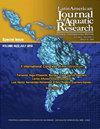1833年,巴塔哥尼亚红鱼Valenciennes(Scorpaenidae)在东南太平洋的首次黑色素沉着记录
IF 0.8
4区 农林科学
Q3 FISHERIES
Latin American Journal of Aquatic Research
Pub Date : 2023-08-31
DOI:10.3856/vol51-issue4-fulltext-2973
引用次数: 0
摘要
鱼类的着色模式变化频率较低。生物体中过量的深色色素被称为黑色素沉着或黑色素沉着,但皮肤完全变黑被称为超黑色素沉着。人们对为什么鱼类会出现白化和黑变病的极端情况知之甚少。到目前为止,还没有关于黑色素的记录。在这里,我们报道了东南太平洋岩鱼眼平皮鱼(巴塔哥尼亚红鱼)的第一例高黑素病。2005年,来自Quintay海滩(智利瓦尔帕莱索)的小规模渔民捕获了一条巴塔哥尼亚红鱼,身上覆盖着过量的深色色素。标本全长35.5厘米,我们根据现有文献确定其形态计量和分生组织特征。测量结果使我们得出结论,该标本是一只患有罕见黑色素沉着病的黑色眼轮虫。我们的发现有助于了解这个物种,我们推断这个黑变病病例是由遗传遗传或某种共生杂交引起的。尽管如此,基因研究仍有必要证实这一假设。本文章由计算机程序翻译,如有差异,请以英文原文为准。
First record of hyper melanosis in the Patagonian redfish Sebastes oculatus Valenciennes, 1833 (Scorpaenidae) in the southeastern Pacific Ocean
The coloration pattern alteration occurs at a low frequency in fish. The excesses of dark pigments in living organisms are known as melanism or melanosis, but a total blackening of the skin is known as hyper melanism or hyper melanosis. Little is known about why the extreme conditions of albinism and melanosis occur among fish. To date, there are no records of melanism for the genus Sebastes. Here, we report the first case of hyper melanosis in rockfish Sebastes oculatus (Patagonian redfish) in the southeastern Pacific Ocean. In 2005, small-scale fishers from Quintay Beach (Valparaiso, Chile) captured a single individual of Patagonian redfish covered with an excess of dark pigmentation. The specimen had a total length of 35.5 cm, and we followed the literature available to determine its morphometric and meristic features. The measurements led us to conclude that the specimen was a black S. oculatus with a rare melanosis condition. Our finding contributes to the knowledge of this species, and we infer that this melanosis case was caused by genetic heritage or some intergenetic hybridization. Still, genetic studies are necessary to confirm this hypothesis.
求助全文
通过发布文献求助,成功后即可免费获取论文全文。
去求助
来源期刊

Latin American Journal of Aquatic Research
FISHERIES-MARINE & FRESHWATER BIOLOGY
CiteScore
1.70
自引率
10.00%
发文量
44
审稿时长
4-8 weeks
期刊介绍:
Latin American Journal of Aquatic Research- LAJAR is the continuation of the journal Investigaciones Marinas (1970-2007) and is published since 2008 by the Escuela de Ciencias del Mar, Facultad de Ciencias del Mar y Geografía of the Pontificia Universidad Católica de Valparaíso. LAJAR is an “Open Access” journal that publishes in English language, original research articles, reviews and short communications on aquatic science, which contain the results of research conducted in aquaculture or in oceanic and coastal marine waters of Latin America.
The following topics are considered: Physical Oceanography, Chemical Oceanography, Marine Biogeochemistry, Marine Pollution and Toxicology, Marine Geology and Geophysics, Biological Oceanography, Fisheries and Aquaculture.
 求助内容:
求助内容: 应助结果提醒方式:
应助结果提醒方式:


